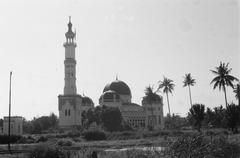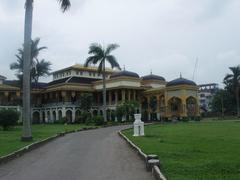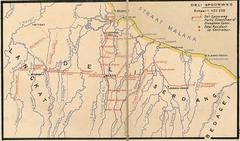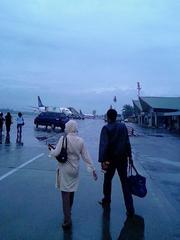Al-Osmani Mosque Visiting Hours, Tickets, and Medan Historical Sites Guide
Date: 04/07/2025
Introduction
Al-Osmani Mosque (Masjid Al-Osmani), also known as Labuhan Mosque, stands as Medan’s oldest and most culturally significant mosque. Founded in 1854 by Sultan Osman Perkasa Alam of the Deli Sultanate, it embodies over a century and a half of Islamic tradition, royal heritage, and architectural ingenuity. Its unique fusion of Malay, Middle Eastern, Indian, Chinese, and European styles reflects Medan’s multicultural past as a vibrant trading port and its ongoing role as a center of religious and community life in North Sumatra. This guide provides everything you need for a meaningful visit, including practical information on visiting hours, tickets, accessibility, travel tips, and nearby historical sites.
(Sultanate Institute; Tribun Medan; The Jakarta Post)
Table of Contents
- Historical Background
- Visiting Information
- Architectural Highlights
- Nearby Attractions
- Visitor Etiquette
- FAQs
- Summary & Conclusion
- Sources
Historical Background
Founding and Early Development
Established in 1854 by Sultan Osman Perkasa Alam, the seventh ruler of the Deli Sultanate, Masjid Al-Osmani was constructed using timber from Kalimantan, transported via the Deli River. Its original 16 x 16-meter structure served as a hub for religious, educational, and social gatherings, welcoming scholars from Yemen and hosting significant Islamic festivities. The mosque’s strategic riverside location near the Belawan coast cemented its role as a spiritual and social anchor for the region (Sultanate Institute; sejarahkesultanandeli.com).
Architectural Transformation and Expansion
In 1870, under Sultan Mahmud Perkasa Alam, the mosque underwent major renovation and expansion to 26 x 26 meters. German architect G. D. Langereis introduced permanent masonry and blended Melayu Deli, Middle Eastern, Indian, Chinese, and European styles—visible in the mosque’s yellow and green façade, Mughal-inspired domes, Chinese ornamental doors, and European columns. The result is a living symbol of Medan’s multicultural heritage (Sultanate Institute; wikipedia.org).
Role in the Deli Sultanate and Urban Life
Located opposite the former Deli Sultanate Palace (now the YASPI Islamic School), Masjid Al-Osmani became the heart of religious, social, and economic activity. Its courtyard doubled as a marketplace (“pekan”), and the mosque played a major role in governing, community events, and festival celebrations.
Preservation and Cultural Legacy
Designated as a protected heritage site, the mosque complex includes the mausoleum of five Deli Sultans—a site of pilgrimage and remembrance. The mosque’s continued maintenance sustains its historical and architectural significance (Tribun Medan).
Community Life and Traditions
Masjid Al-Osmani remains a vibrant religious and social hub, hosting daily and Friday prayers, Quranic education, Ramadan Tarawih, communal iftars, and the beloved “Bubur Pedas” tradition during Ramadan. Its ongoing role as a community center highlights its enduring importance in the local Muslim and broader Medan community.
Visiting Information
Visiting Hours
- Daily: 8:00 AM – 6:00 PM
- Special Hours: Extended during Ramadan for Tarawih prayers and community events
- Note: Access to the prayer hall may be restricted during congregational prayers, especially on Fridays (12:00 PM – 2:00 PM) and Islamic holidays
Entry & Accessibility
- Admission: Free of charge; donations are welcomed
- Wheelchair Access: Ramps at the main entrance; accessible prayer spaces
- Parking: Available on-site, but limited during peak periods
Guided Tours and Travel Tips
- Guided Tours: Available upon request via local tour operators or the mosque’s community center; English-speaking guides recommended for non-Indonesian visitors
- Photography: Permitted in exterior and courtyard areas; always seek permission before photographing worshippers or ceremonies
- Best Time to Visit: Early morning or late afternoon on weekdays; dry season (May–September) for optimal weather
- Dress Code: Modest attire required—women should wear a headscarf, men should avoid shorts and sleeveless shirts (Blue Mosque Dress Code Guide; Alhannah Mosque Attire Guide)
Architectural Highlights
Exterior Features
- Color Palette: Distinctive golden yellow (symbolizing Malay royalty) with green and blue accents
- Domes & Minaret: Onion-shaped dome with Mughal and Ottoman influences; elegant minaret with Middle Eastern and Indian details
- Entrance: Pointed arches, floral and vegetal motifs, and symmetrical towers with miniature domes
Interior Design
- Prayer Hall: Spacious, with carved wooden columns and decorated mihrab featuring Quranic calligraphy and tiles
- Decorative Elements: Gold and blue calligraphy, geometric window grilles, and floral motifs
- Natural Light: Stained glass windows cast yellow and green hues across the prayer hall
Materials and Influences
- Construction: Local bricks, hardwoods, imported tiles, and stained glass
- Architectural Synthesis: Seamlessly blends Malay, Chinese, Indian, Middle Eastern, and European styles, exemplifying Medan’s pluralistic history (acnescarsremediesgo.blogspot.com)
Conservation Efforts
- Ongoing Restoration: Structural repairs, woodwork restoration, and color maintenance are undertaken with community support to preserve the mosque’s status as an active place of worship and cultural heritage site
Nearby Attractions
- YASPI Islamic School: Former site of the Deli Sultanate Palace
- Labuhan Harbor: Bustling port area reflecting Medan’s trading legacy
- Great Mosque of Medan (Masjid Raya Al Mashun): Iconic religious landmark
- Maimun Palace: Royal palace of the Deli Sultanate
- Tjong A Fie Mansion: Historic Chinese-Indonesian heritage home
- Pekong Lima Chinese Temple: Testament to Medan’s religious diversity (Travelspilot)
Visitor Etiquette
- Dress modestly (long sleeves, long pants/skirts, headscarf for women)
- Remove footwear before entering the prayer hall
- Speak softly and be respectful of worshippers
- Refrain from eating, drinking, or using mobile phones inside
- Supervise children to maintain a peaceful atmosphere
Frequently Asked Questions (FAQ)
Q: What are the visiting hours?
A: 8:00 AM to 6:00 PM daily, with extended hours during Ramadan. Avoid visiting during Friday midday prayers.
Q: Is there an entrance fee?
A: No, entry is free. Donations are welcome.
Q: Are guided tours available?
A: Yes, through local guides or tour operators. Advance booking is recommended for English-speaking tours.
Q: Is the mosque accessible for people with disabilities?
A: The main entrance and courtyard are accessible by ramp; some areas may have steps.
Q: Can non-Muslims visit?
A: Yes, outside of prayer times. Non-Muslims should avoid entering the main prayer area during worship.
Q: Is photography allowed?
A: Yes, in exterior and courtyard areas. Always ask before photographing people or religious ceremonies.
Summary & Conclusion
Al-Osmani Mosque is a living heritage site that captures the heart of Medan’s history, culture, and spiritual life. Its architectural splendor, royal legacy, and role as a community center make it a must-visit destination for travelers seeking to explore North Sumatra’s rich past and dynamic present. With free entry, accessible facilities, and proximity to other cultural landmarks, the mosque offers an inclusive and enriching visitor experience. Plan your visit to connect with Medan’s diverse heritage, and download the Audiala app for more travel tips, guided tours, and historical insights.
Visuals and Media
Exterior view of Al-Osmani Mosque showcasing its vibrant yellow façade and distinctive dome.
Interior prayer hall featuring carved wooden columns and Islamic calligraphy.
View Al-Osmani Mosque on Google Maps
Key Facts at a Glance
- Founded: 1854 by Sultan Osman Perkasa Alam
- Major Renovation: 1870–1872 by G. D. Langereis (Germany)
- Architectural Styles: Malay, Chinese, Indian, Middle Eastern, European
- Distinctive Features: Golden yellow façade, Mughal dome, royal mausoleum
- Location: Jl. Kol. Yos Sudarso, Medan Labuhan, Medan, North Sumatra
- Admission: Free
- Cultural Status: Protected heritage site
Sources and Further Reading
- Sultanate Institute
- Tribun Medan
- The Jakarta Post
- Islamic Architectural Heritage
- Travelspilot
- Blue Mosque Dress Code Guide
- Alhannah Mosque Attire Guide
- acnescarsremediesgo.blogspot.com




